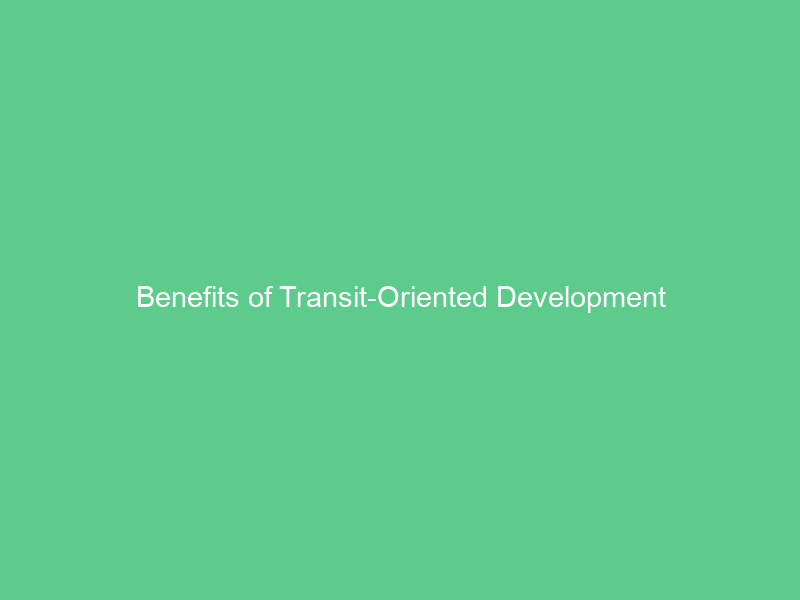TOD (Transit Oriented Development) refers to urban growth that integrates jobs, services and housing alongside quality public transportation in an organized, walkable fashion – helping reduce dependence on automobiles while encouraging shorter commutes and healthier lifestyles.
Research demonstrates the many advantages of TOD for productivity, livability and resilience against natural disasters. A new report explores how cities can identify opportunities for TOD development through using the 3V framework of transit connectivity, accessibility and market potential to identify areas for TOD development.
Concentration of Jobs and Housing Around Transit Stations
People and households are increasingly drawn to areas near transit stops where they can find jobs, services and housing – making public transit an attractive alternative to car travel that both pollutes the environment and wastes time commuting time. This development helps make using public transport an attractive option and decreases car trips that pollute our environment and waste valuable commute time.
Planners aim to enhance these areas even further by designing them to be walkable and linked with other parts of the city – making it easier for people to access places without driving – but high demand for housing near transit stations may lead to higher housing costs and gentrify neighborhoods, undermining equity goals.
Conventional wisdom suggests that households with children would be attracted to living near transit, yet our research showed only very few such households actually moving into the first 100 meters around LRT, BRT, and HRT stations. This may reflect demographic shifts or may simply indicate there aren’t enough affordable homes nearby for such families to reside.
More Efficient Transportation
TODs (Transit Oriented Developments) create walkable mixed-use neighborhoods centered on public transit stations, thus decreasing your need for driving and carbon footprint. A recent Brookings study discovered that people living closer to multiple “activity centers” can save anywhere from $920-1,200 annually on transportation expenses by cutting driving by up to 85%.
An effective TOD strategy prioritizes residential development along public transit corridors, providing affordable housing with convenient access to jobs, services and amenities that will address growing population needs while increasing livability for all residents.
TOD requires robust, high-frequency transit that connects housing, jobs and shopping destinations. A TOD planning policy must also prioritize new development near mass transit over sprawling car-oriented development; and offer incentives that leverage public transport access as part of meeting developers’ goals – ultimately helping reduce car use while simultaneously decreasing infrastructure expenses like roads and parking requirements.
More Livable Communities
TOD often results in residential and business areas located within walking distance of transit stations, offering residents easy access to jobs and services while helping them commute without using their cars for everyday errands or recreational needs.
Mode-switching lowers household transportation costs while reducing emissions that contribute to climate change, increasing community health by providing access to healthy foods, retail shops and social activities; studies also show that households living in TOD neighborhoods save an average of $3,000 each year in automobile and parking costs (Cervero & Arrington 2008).
Although eTOD can be an effective means of increasing public transit ridership and expanding opportunities, its implementation must follow equitable processes in order to be truly beneficial. Otherwise, housing near transit could become oversaturated, leading to gentrification or displacement and pricing out people with lower incomes from participating. Equitable implementation requires strong tenant protection policies, housing affordability measures and community-based planning.
Increased Resilience
Transit-oriented development (TOD) helps cities and towns reduce congestion while also creating economic opportunity. By centralizing jobs, services, and housing near stations, TOD makes public transit an attractive and efficient mode for work and leisure travel – more people may opt to ride the bus – leading to lower commuting costs and improved health outcomes.
TOD also assists communities in building resilience against natural hazards and climate change, by prioritizing high density residential and commercial development in areas with lower exposure risks while encouraging investments into resilience infrastructure in more vulnerable locations.
TOD can facilitate equitable transit access for low-income people through affordable housing near station areas, while also encouraging community connections through activities while providing safe spaces to come together and create a sense of place. TOD is one of the cornerstones of Smart Growth principles, which emphasize preserving local economies through compact, sustainable developments.

